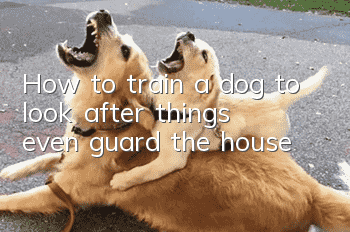How to train a dog to look after things, even guard the house?

Steps to train a dog to look after things
Commonly used habitual commands such as: "pay attention" and "watch".
Basic theory of training: Dogs with a strong desire to pick are trained based on food conditioned reflexes, defensive conditioned reflexes.
Training should be carried out on the basis that the dog has the ability to sit and lie down, bark, pick up, and bite.
The first step is to train dogs to protect their food. In fact, it is a dog's nature to protect food. When feeding in the morning, the dog owner will tie the dog outside and give the dog 1 to 2 bites of food, and then push the dog food to the place where the dog wants to eat but can't eat it. Give the commands "attention" and "watch", and ask the assistant trainer to bring another dog to pretend to ask for food. To put it bluntly, you might not eat it if you did this, but at this time the dog's conditioned reflex when seeing the food has stimulated its original desire. The trained dog will inevitably become anxious and bark and bite, and the dog owner will reward it. Then let the trained dog eat the food. If you have listened to some basic lectures by a so-called dog breeder in Taiwan, you will easily understand that the entire dog training process is actually a process of nurturing with your heart. Dogs are simple, but people are complex. Well, if the trained dog does not bark or bite during this process, the dog owner should make the dog bark in time. After training like this 3 to 4 times, use this method to train the dog to protect the food bowl, bones, bone-wrapped towels, and even gloves.
The second step is to cultivate the dog's protective desire. Tied up the dog, put the best thing in front of it, and give the "look" and "look" commands. Assist the trainee to sneak in front of the dog and take samples. After the dog barks and bites, the trainee immediately runs away. The dog's owner picks up something and rewards the dog. If the assistant pretends to come up to get something, the dog will not bark or bite, and the dog owner should immediately let the dog bark. Sometimes you just need to help it know what it means.
The fourth step is to make the dog lie down (or sit down) without a leash, put the object in front of the dog, and give the "attention" and "watch" commands. After a certain period of time, the assistant trainer wears protective sleeves in front of the dog. Come and get the object. If the dog takes the initiative to bite, the dog will be rewarded; if the dog does not take the initiative, the dog owner will make the dog bite, then the assistant trainer will drop the object, and then reward the dog.
The fifth step is to make the dog lie down (or sit down) without a leash, put the object in front of the dog, give the "attention" and "watch" commands, the dog owner leaves, and the assistant trainer wears a protective sleeve. Come and get the object, and the dog alone completes the behavior of biting the assistant and watching the object.
Things to note when training a dog to look after things
① During the initial training, the assistant trainer will first bring the dog to grab food, and then the assistant trainer will come alone. It's fastened, don't bite it.
②As soon as the dog shows signs of attacking the trainer, the trainer should pretend to be afraid and retreat. It's not easy to be an assistant trainer.
③The time for the dog to lie down or sit down alone to guard something should be from short to long, from about 10 minutes to 3 to 4 hours.
④The items being guarded should be changed frequently, until large items (properties) such as luggage and cars are being guarded. Step by step.
⑤ When dogs are guarding items, they should be prevented from playing with or biting items. Don't give it a chance to bite.
⑥ should be combined with dog food resistance training to prevent others from poisoning the dog and harming the dog.
- Is it better for Dogo dogs to have their ears erect or cropped? A case of Dogo dog’s ear erection surgery will tell you
- What do dogs eat to protect their stomach? It is important to protect their stomach and treat gastrointestinal diseases in dogs.
- How to tell if your dog is fat? Is your dog overweight?
- Will your dog catch a cold if you blow the air conditioner? What should you do if your dog catches a cold if you blow the air conditioner?
- What should you pay attention to when your dog drinks water? Don’t be careless when it comes to your dog’s drinking water.
- The dog's mouth bites and shakes. Why does the dog's mouth occasionally shake and bite?
- How to cut a dog's hair? Do you know how to cut a dog's hair correctly?
- Can dogs eat raw eggs? Why can’t dogs eat egg whites?
- Common Dog Problems in Summer How to Deal with Different Dog Problems
- How to keep dogs away from skin diseases. If you do this, will you see if your dog will still be infected with skin diseases?



